R.J. Stowell's Blog: rjsomeone, page 76
April 28, 2018
Bee Gees Odessa
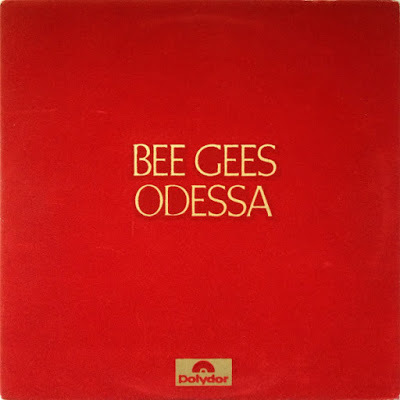 Despite what may be the most lavish LP cover in rock history, a velour sleeve in a deep red stamped in gold with the album's title and band name, the Bee Gees' epic was nonetheless doomed from the get-go. Fans had grown accustomed to the psych-pop of Idea and 1st and had gobbled up hits like "Holiday," but for this, they merely scratched their heads. Indeed the Gibb brothers themselves derided producer Robert Stigwood for browbeating them into such a grandiose venture, despite the infighting that had them disagree on everything else.
Despite what may be the most lavish LP cover in rock history, a velour sleeve in a deep red stamped in gold with the album's title and band name, the Bee Gees' epic was nonetheless doomed from the get-go. Fans had grown accustomed to the psych-pop of Idea and 1st and had gobbled up hits like "Holiday," but for this, they merely scratched their heads. Indeed the Gibb brothers themselves derided producer Robert Stigwood for browbeating them into such a grandiose venture, despite the infighting that had them disagree on everything else. My grandmother worked for a psychiatrist as a housekeeper in 1969. She'd take me at times to their home, a beautiful mid-century modern structure with a bright red door, a pool and a guesthouse. I'd play with the dogs, dalmatians; she'd give me lunch in a bright red kitchen, and then she'd let me sit in the son's room and play his records. One of those records was Odessa. I liked the look and feel of it, the soft velvet – the music, not so much (it was on that same day that I first heard Tommy as well). I never owned Odessa. Years later I'd picked it up in a record store bin and put it back down. A mint copy is today on my bucket list.
As the years sailed by, the fearless ambition of Odessa became more difficult to dismiss. Like sonic landmarks with similar histories – Pet Sounds, Forever Changes – Odessa finds its authors amid personal crisis while working at the absolute peak of their powers. Capping a furious two-year whirlwind in which the group produced four albums and half-a-dozen Top 40 singles, arguments over Odessa's production, coupled with an exhausting schedule, created a battle between Barry and Robin Gibb for the leadership of the group. Though they finally reconvened in 1971, they never again produced a work as focused and affecting as Odessa.
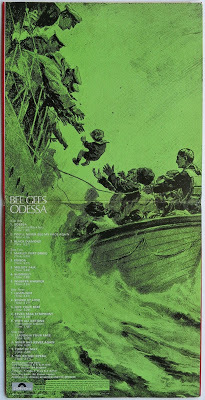 This was the Bee Gees' fourth album of all-original material in just over 18 months and a double LP at that. Odessa may be the pinnacle of "baroque-pop," with its lush string arrangements and lavish production. It starts and ends quite remarkably, opening with the 7-minute epic title track and closing with the instrumental "The British Opera." If it sounds pretentious, you bet, but keep in mind that it was recorded in the days when pretension was called ambition (think Let It Be). That said, not everything works. The album's two excursions to the wild west failed to move me and few critics find the necessity in the instrumentals (I like them). Far better are the last vestiges of the silly-psychedelia the band permitted themselves, which made their first two albums such fun, namely "Edison", "Suddenly" and "Whisper Whisper."
This was the Bee Gees' fourth album of all-original material in just over 18 months and a double LP at that. Odessa may be the pinnacle of "baroque-pop," with its lush string arrangements and lavish production. It starts and ends quite remarkably, opening with the 7-minute epic title track and closing with the instrumental "The British Opera." If it sounds pretentious, you bet, but keep in mind that it was recorded in the days when pretension was called ambition (think Let It Be). That said, not everything works. The album's two excursions to the wild west failed to move me and few critics find the necessity in the instrumentals (I like them). Far better are the last vestiges of the silly-psychedelia the band permitted themselves, which made their first two albums such fun, namely "Edison", "Suddenly" and "Whisper Whisper."Elsewhere they settle into solid balladry including the remarkably candid "I Laugh In Your Face" and "You'll Never See My Face Again", the should-have-been-a-hit "Lamplight" and the yearning "Never Say Never Again". The two singles, both nearly child-like in their simplicity and far from chart-toppers, "First Of May" and "Melody", fail to stand out in the good company here. Odessa spawned a family feud over whose song should get to be a single which escalated into a two-year hiatus. After that, the brothers were never the same again as they struggled to reinvent themselves for the new decade. Of course they did, and spectacularly, somewhere out on the dance-floor, but that is a whole different discussion.
Published on April 28, 2018 05:54
April 27, 2018
Bee Gees - Horizontal and Idea
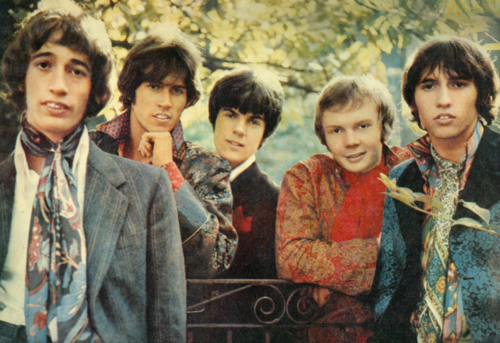 My collection of Bee Gees music is a mainstay of my 45 collection, with incredible songs like "Holiday," "I Started a Joke" and "How Can You mend a Broken Heart." My LP collection contains only the Bee Gees 1st (actually their third LP; the first released internationally), a sadly overlooked LP from 1967 and the concept LP Odessa. The criticism of early BeeGees has always been the Beatles comparisons but 1st, and particularly the epic Odessa, are worthy of far more serious attention. With a single as impressive as "Holiday," why Bee Gees 1st is overlooked is a mystery. Obviously, the band's venture into disco flash precludes many of us from even saying the name without turning to stone, 1st stands out amongst the plethora of psychedelia that flanked AM radio by 1968 (yes, unlike Pink Floyd or the 13th Floor Elevators, the Bee Gees brand of Psychedelia was pure pop). The brothers' second (or 4th) LP, Horizontal, is one of 1968's forgotten gems.
My collection of Bee Gees music is a mainstay of my 45 collection, with incredible songs like "Holiday," "I Started a Joke" and "How Can You mend a Broken Heart." My LP collection contains only the Bee Gees 1st (actually their third LP; the first released internationally), a sadly overlooked LP from 1967 and the concept LP Odessa. The criticism of early BeeGees has always been the Beatles comparisons but 1st, and particularly the epic Odessa, are worthy of far more serious attention. With a single as impressive as "Holiday," why Bee Gees 1st is overlooked is a mystery. Obviously, the band's venture into disco flash precludes many of us from even saying the name without turning to stone, 1st stands out amongst the plethora of psychedelia that flanked AM radio by 1968 (yes, unlike Pink Floyd or the 13th Floor Elevators, the Bee Gees brand of Psychedelia was pure pop). The brothers' second (or 4th) LP, Horizontal, is one of 1968's forgotten gems.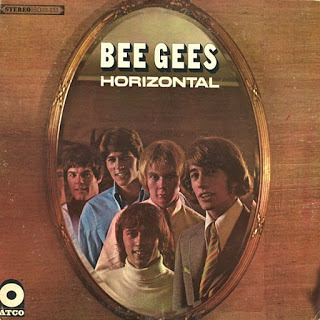 As before, the variety of styles covered is almost dizzying. Starting off strongly with the spacey, psychedelic U.K. hit single "World", we get a couple of predominantly Robin tracks, which, while melodic, suffer from his over-excited vocal style. When brother Barry takes the lead, we land on stronger ground. The Beatles' influence remains, but I rather enjoy playing "Spot the Beatles", in songs like "Day Time Girl," Which sounds like all of McCartney's strings-laden ballads rolled into one, "The Earnest Of Being George,” heavying it up a-la "I Am The Walrus" and the closing title track falling somewhere between "Tomorrow Never Knows" and the Stones "2000 Light Years From Home." Despite the influence, these are top-notch tunes, the boys ability to so cleverly "follow-the-leader" does a fab job of filling very big footprints.
As before, the variety of styles covered is almost dizzying. Starting off strongly with the spacey, psychedelic U.K. hit single "World", we get a couple of predominantly Robin tracks, which, while melodic, suffer from his over-excited vocal style. When brother Barry takes the lead, we land on stronger ground. The Beatles' influence remains, but I rather enjoy playing "Spot the Beatles", in songs like "Day Time Girl," Which sounds like all of McCartney's strings-laden ballads rolled into one, "The Earnest Of Being George,” heavying it up a-la "I Am The Walrus" and the closing title track falling somewhere between "Tomorrow Never Knows" and the Stones "2000 Light Years From Home." Despite the influence, these are top-notch tunes, the boys ability to so cleverly "follow-the-leader" does a fab job of filling very big footprints.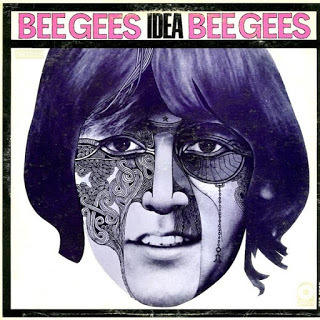 There is no doubt that the Bee Gees wanted to be the Beatles, who didn’t, but the Bee Gees fit unequivocally into that 2nd tier of Beatle-Pop alongside bands like The Hollies and The Dave Clark Five. Idea, the Bee Gees third international release was equally strong and included two stellar hits, "I've Gotta Get a Message to You" (not on the U.K. release) and "I Started a Joke." Here the LP sheds some of its influences and the brothers start to find a voice of their own; a voice that would lead them by the end of 1968 to the recording of Odessa, an LP that sits amidst the best of the most overlooked and underrated albums of all time (Oddysey and Oracle (sic), SF Sorrow, Ogden’s Nut Gone Flake).
There is no doubt that the Bee Gees wanted to be the Beatles, who didn’t, but the Bee Gees fit unequivocally into that 2nd tier of Beatle-Pop alongside bands like The Hollies and The Dave Clark Five. Idea, the Bee Gees third international release was equally strong and included two stellar hits, "I've Gotta Get a Message to You" (not on the U.K. release) and "I Started a Joke." Here the LP sheds some of its influences and the brothers start to find a voice of their own; a voice that would lead them by the end of 1968 to the recording of Odessa, an LP that sits amidst the best of the most overlooked and underrated albums of all time (Oddysey and Oracle (sic), SF Sorrow, Ogden’s Nut Gone Flake). Apart from the hits, the album is filled with clever progressive baroque pop. "Let There Be Love" is a beautiful love ballad that could have been a single. The bouncy "Kitty Can" and "Indian Gin and Whiskey Dry" are simple novelty pop tunes, while "In the Summer of His Years" and "Down to Earth" are tragic ballads, while "Kilburn Towers" is an excellent smooth jazz experimentation that works oddly with Barry's vocals. The last track "Swan Song" beautifully closes an LP in which the sum more than exceeds the parts, even monster parts like "I Started a Joke."
Next Up: Odessa
Published on April 27, 2018 06:11
The Bee Gees 1st
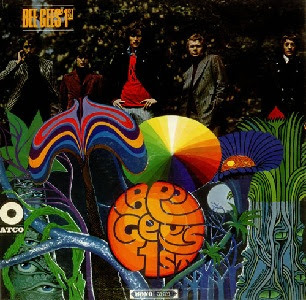 The Beatles' influence has been a substantial thrust in the music industry for more than 55 years. There are artists in which the stimulus is obvious - ELO comes to mind - or those like Billy Corgan of Smashing Pumpkins for whom the influence is only subtly apparent (Corgan states that The Beatles and The Beach Boys were his greatest inspiration). When one thinks of the Bee Gees, "Stayin' Alive" is the obvious allusion; one couldn't be further removed from Penny Lane. (At AM, we’d like to state categorically that we never stepped foot in a discotheque, that we never hoped they'd play "Nights on Broadway" – but that would be a lie.)
The Beatles' influence has been a substantial thrust in the music industry for more than 55 years. There are artists in which the stimulus is obvious - ELO comes to mind - or those like Billy Corgan of Smashing Pumpkins for whom the influence is only subtly apparent (Corgan states that The Beatles and The Beach Boys were his greatest inspiration). When one thinks of the Bee Gees, "Stayin' Alive" is the obvious allusion; one couldn't be further removed from Penny Lane. (At AM, we’d like to state categorically that we never stepped foot in a discotheque, that we never hoped they'd play "Nights on Broadway" – but that would be a lie.)And yet, despite their reign as the ultimate disco stars, there are indeed other Bee Gees with a string of Beatlesque hits spanning a four-year period from 1967 to 1971 (beginning with "New York Mining Disaster, 1941"). The LP, Bee Gees 1st, fits right next to Sgt. Pepper et al with its psychedelic pop, baroque meanderings and sumptuous harmonies. With an album cover designed by Klaus Voorman (Revolver), it's easy to compare the Brothers Gibb to the Beatles during this era, yet the Bee Gees had an originality of their own that highlighted odd time signatures, Renaissance-era cathedral sounds and mellotron, Moody Blues style.
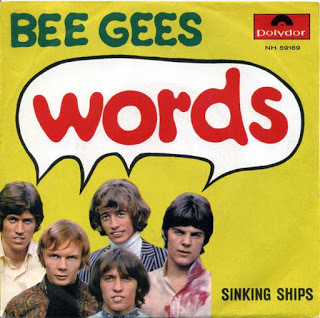 After auditioning for and being signed to Polydor Records (ATCO in the U.S.), the Bee Gees were hailed as "The Most Significant New Talent Of 1967." Bee Gees 1st ended the year at No. 7 on the U.S. charts and No. 8 in the U.K. The album featured 14 tracks spawning three top 30 hits, all originals and chock full of progressive pop, melancholy harmonies, orchestral arrangements and shades of psychedelia. Rhythm and blues influences abounded as well; indeed, "To Love Somebody" was originally written for Otis Redding and went on to be recorded by 250 other artists.
After auditioning for and being signed to Polydor Records (ATCO in the U.S.), the Bee Gees were hailed as "The Most Significant New Talent Of 1967." Bee Gees 1st ended the year at No. 7 on the U.S. charts and No. 8 in the U.K. The album featured 14 tracks spawning three top 30 hits, all originals and chock full of progressive pop, melancholy harmonies, orchestral arrangements and shades of psychedelia. Rhythm and blues influences abounded as well; indeed, "To Love Somebody" was originally written for Otis Redding and went on to be recorded by 250 other artists.For me, "Holiday" holds significance as the first single I ever bought with my own money. With my help it was the first Bee Gees song to become a rock standard. "Holiday" is an oddly arranged track with a structure strictly orchestral and without percussion (other than an out-of-nowhere snare drum beat during the “dee-dee-dee-dee-dee-dee" bridge). The bridge brilliantly reappears as a strange, unresolved coda at song's end, leaving the ending hanging in a fashion that suits the unanswered questions Robin Gibb poses throughout his vaguely poetic lyrics. ("It's something I think's worthwhile/If the puppet makes you smile/If not then you're throwing stones, throwing stones, throwing stones.” - I don’t know, either, but how cool is that?) Yet for all the oddity of the structure and lyrics, Barry Gibb's melody is so hauntingly beautiful, with some of the most magical backing harmonies (in an era of harmony), that "Holiday" remains one of psychedelia's most remarkable tunes. The band would follow it up with a string of ethereal, top-notch hits that included "Massachusetts," "Words," "I've Gotta Get a Message to You" and "I Started a Joke," one of rock's most melancholy tunes.
Bee Gees 1st is a psychedelic classic and orchestral pop masterpiece - easily one of the ten most melodic albums of original material ever released, and by the youngest band ever to record an out and out classic album (Barry was 19 and Robin and Maurice incredibly only 17). It also (improbably) seems to be the first indisputably psychedelic album released by a U.K. band outside the Beatles, when it hit the shops in late July '67, though it seems unlikely that no British act released a clearly psychedelic album in the year following Revolver. One might include Donovan’s Sunshine Superman, but that wasn't released in the UK until June 67 (Aug '66 in the USA) and I would categorize it more as hippie-folk rather than indisputable psychedelia. The Bee Gees were a real group then - a five piece, with drums and lead guitar. The sound quality and production is first rate and the orchestral arrangements (by Billy Shepherd) are the best of the era, second only to George Martin's work with the Beatles. (Incidentally Billy Shepherd is not even mentioned on the album sleeve!) Bee Gees 1st reached a modest No. 8 in the U.K., but the Bee Gees were triumphant in the U.S.A. and the album yielded 3 American hits.
Published on April 27, 2018 06:10
April 26, 2018
A Little Help From My Friends - Joe Cocker
 The early 60s found the Tin Pan Alley tradition unstifled. Rock musicians from the most obscure to The Beatles covered the songs of other artists, but specifically the tunes of songwriters; the age of the auteur had yet to arrive. In popular music, the singer-songwriter was nearly unheard of. Bing to Frank to Elvis never wrote a song – that was someone else's job. On Please, Please Me, six of the tracks, for instance, were covers. The Beatles, though, were the catalyst for the demise of the song stylist, with one glaring and impressive exception – Joe Cocker. In early 1968, but not released until 1969, Cocker recorded his debut. In addition to that gravelly, soulful voice that so often earned him comparisons to Ray Charles, Cocker was the premier interpreter of other peoples' songs, and one of the last.
The early 60s found the Tin Pan Alley tradition unstifled. Rock musicians from the most obscure to The Beatles covered the songs of other artists, but specifically the tunes of songwriters; the age of the auteur had yet to arrive. In popular music, the singer-songwriter was nearly unheard of. Bing to Frank to Elvis never wrote a song – that was someone else's job. On Please, Please Me, six of the tracks, for instance, were covers. The Beatles, though, were the catalyst for the demise of the song stylist, with one glaring and impressive exception – Joe Cocker. In early 1968, but not released until 1969, Cocker recorded his debut. In addition to that gravelly, soulful voice that so often earned him comparisons to Ray Charles, Cocker was the premier interpreter of other peoples' songs, and one of the last.It goes without saying that Cocker was one galvanizing front man. You couldn't take your eyes off him. He didn't just stand before the microphone and sing. No, he twitched, gesticulated, swayed, waved his arms about wildly, wriggled his fingers, played air guitar, and in general looked like a guy attacked by bees.
 Cocker began his career with obscure groups like the Cavaliers and Vance Arnold and the Avengers, then moved on to The Grease Band in 1966. Americans wouldn't discover him until his magnificent and unrivaled Woodstock performance. Cocker, by Woodstock, was renowned for his interpretations of songs by artists as varied as The Beatles, Dave Mason, Bob Dylan, Leonard Cohen, and The Box Tops; interpretations that, often as not, blew away the originals. Often the listener was unaware that Cocker's version wasn't the original. Unfortunately, Cocker was also an alcoholic, and the stories (not all of them true, I'm sure) of his coming onto the stage, throwing up on the audience, and passing out, are legion.
Cocker began his career with obscure groups like the Cavaliers and Vance Arnold and the Avengers, then moved on to The Grease Band in 1966. Americans wouldn't discover him until his magnificent and unrivaled Woodstock performance. Cocker, by Woodstock, was renowned for his interpretations of songs by artists as varied as The Beatles, Dave Mason, Bob Dylan, Leonard Cohen, and The Box Tops; interpretations that, often as not, blew away the originals. Often the listener was unaware that Cocker's version wasn't the original. Unfortunately, Cocker was also an alcoholic, and the stories (not all of them true, I'm sure) of his coming onto the stage, throwing up on the audience, and passing out, are legion.In 1968, Cocker got a lot of help from his friends, 24 of whom assembled to make the album, including Jimmy Page, Steve Winwood, Albert Lee, Matthew Fisher and B.J. Wilson of Procol Harum, David Bowie producer Tony Visconti, and oodles of sessions musicians, to say nothing of the great American soul singers Merry Clayton and Madeline Bell.
LP opener and Dave Mason cover "Feelin' Alright" (sic) is one of Cocker's trademark tunes. It opens with the instantly familiar piano riff by Artie Butler and the waay cool maracas and tumba of the mysterious "Laudir" (sounds like a magician instead of a musician). Then Cocker comes in singing, "Seems I’ve got to have a change of scene/ Every night I have the strangest dream," and on he goes until the Stonesy chorus, which features the guitar of David Cohen and backup vocals by Clayton and Holloway sisters, Brenda and Patrice. "Bye Bye Blackbird" is a slow soul number, with Cocker letting it all hangout, though the song’s highlight is the amazing guitar solo by Jimmy Page, which comes out of nowhere and proceeds to singe off the listener's eyebrows.
Cocker co-wrote "Change in Louise" with pianist and long-time mainstay Chris Stainton. It's not the LP's best tune, but it boasts a hot chorus and Cocker grows increasingly frantic as the song goes on, repeatedly arcing back to the refrain, "Who else but me can see the change in Louise?"
Call it freshman overconfidence, or just a bad choice, Cocker and Stainton’s “Majorine” is misplaced and a skipper. Both Page and Lee play on the track, but I'll be damned if I can hear them; rather, its Stainton on piano who does all the heavy lifting. Cocker, here, is the picture of restraint (while I prefer him in "Mad Dog" mode). "Do I Still Figure in Your Life," is a slow, soulful number that proves again a bit too restrained but for Steve Winwood's stellar organ work. Listen instead to this track at Woodstock, where Cocker really lets loose.
 "Sandpaper Cadillac" is another original composition in which Cocker is full of woe because his car died ("My car is dead and gone, Lord/And I just can’t carry on"). His car "wants to be free, I know/ And it's calling out to me, yeah," so maybe its death is a good thing. Then Cocker's walking along "with a gold-plated pussycat/ Somebody"s pouring blood on its back”"and the cat is all alone without a bone and Joe knows it, just as he knows his car and cat "are going bad/And I need everything I can, Lady." I'll give 5 bucks to anybody who can tell me what the hell is going on.
"Sandpaper Cadillac" is another original composition in which Cocker is full of woe because his car died ("My car is dead and gone, Lord/And I just can’t carry on"). His car "wants to be free, I know/ And it's calling out to me, yeah," so maybe its death is a good thing. Then Cocker's walking along "with a gold-plated pussycat/ Somebody"s pouring blood on its back”"and the cat is all alone without a bone and Joe knows it, just as he knows his car and cat "are going bad/And I need everything I can, Lady." I'll give 5 bucks to anybody who can tell me what the hell is going on.Is there anyone who hasn’t covered "Please Don’t Let Me Be Misunderstood"? (Nina Simone, The Animals, Santa Esmeralda, Elvis Costello, Arthur Brown, The Moody Blues, Julie Driscoll, Lou Rawls, Cyndi Lauper, Einstein (it's on his 1944 Telefunken LP Einstein Sings The Animals), yet Cocker's moody,slowed-down version is textbook song styling. Tommy Eyre's organ is like, happening, maaaan, and includes a fab solo that segues into a guitar freak-out that coaxes the passion out of Cocker.
"With a Little Help From My Friends" is a stoner classic and several evolutionary leaps above the Beatles' version. It's a marvel, really; Cocker and Company transform what is essentially a pleasant little ditty into a full-blown rock opera that opens with organ by Tommy Eyre, lots of mighty cymbal crash by B.J. Wilson, and one very cool riff by Page. Then it quiets and Cocker sings those immortal words, "What would you do if I sang out of tune/ Would you stand up and walk out on me?" followed by the mighty chorus, featuring Bell, Hightower, and the Wheetman sisters singing back up who join in on the second verse when they ask the questions (“Does it worry you to be alone”) to which Joe responds (“No, no”). Page plays a gigantic guitar riff and the back-ups wail and Joe wails right along with them and it's just so, like, heavenly groovy. And the soft-loud dynamic continues with the loud predominating until Cocker lets out one of the greatest screams this side of Roger Daltry. It’s amazing stuff and my favorite adaptation of a Beatles' song by a Liverpudlian kilometer.
Cocker closes the album with Dylan's "I Shall Be Released." The mad man's version is not as bewitchingly sad and lovely as The Band's, (whose is?), but Cocker's incredible ear for the blues is appropriately mournful.
Joe Cocker's career would carry on past Mad Dogs, but don't bother, don't spoil it for yourself. You want Cocker, stick to this, Mad Dogs and Woodstock.
Published on April 26, 2018 06:55
April 25, 2018
A Saucerful of Secrets - Pink Floyd
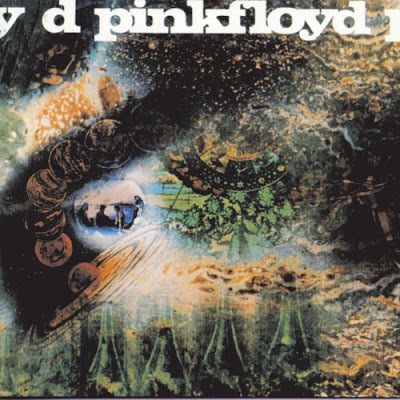 Recorded at Abbey Road Studios from mid-1967 through early '68. A Saucerful of Secrets was produced by Norman Smith, primary sound engineer on virtually every Beatles recording through the end of 1965. The LP was a milestone in Pink Floyd's history as it marked the end of one incarnation of the band and the beginning of another. Like Yes a few years later, the original band was a far cry from what it would become.
Recorded at Abbey Road Studios from mid-1967 through early '68. A Saucerful of Secrets was produced by Norman Smith, primary sound engineer on virtually every Beatles recording through the end of 1965. The LP was a milestone in Pink Floyd's history as it marked the end of one incarnation of the band and the beginning of another. Like Yes a few years later, the original band was a far cry from what it would become.Unlike Piper at the Gates of Dawn, which had received respectable airplay and critical acclaim, Saucerful failed to chart. Rolling Stone called it "a lot of uninteresting noise," and said it was "boring melodically, harmonically and lyrically" with instrumental work that was "shoddy and routine." Shifting roles within the band was the likely cause, though retrospectively the LP shows the band delving further into the electronic soundscapes they would develop over the next few years. The lengthy (11:57) "A Saucerful of Secrets" suite is an excellent example of melding avant-garde electronic experimentation, Rick Wright's celestially modulated keyboard, and glimpses of song snippets, themes that the Floyd would revisit over the next few years, perfecting them on Dark Side. There is the meditative and somewhat menacing Water's piece "Set the Controls for the Heart of the Sun" and two spacey psychedelic numbers loaded with mellotron by Rick Wright, "Remember a Day" and this writer's favorite "See Saw." "Corporal Clegg" earmarks the catalyst of Roger Water's increasing focus on his father's death in the war and features a few riffs on the guitar from Syd. The truly odd track on the album is Syd Barretts' "Jugband Blues," a chaotic mix of Salvation Army Band (he told them to play whatever they felt like playing), kazoo, and a penchant for asymmetric and surreal lyrics. It would prove to be his last studio performance with the group. Where the LP suffered was in production and yet, 50 years on, the remasters create a whole new sound, well worth revisiting.
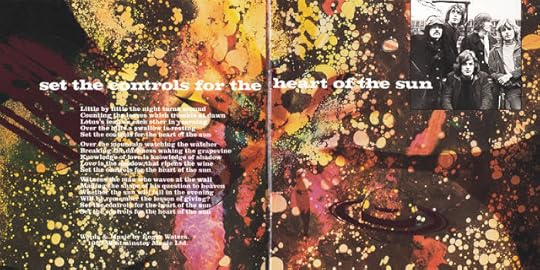 By the end of 1967, Waters, Wright and Mason were becoming increasingly concerned about Barrett, the creative genius behind Pink Floyd, whose heavy psychedelic drug use and erratic behavior threatened to derail them. Mason approached David Gilmour, a college mate of Barrett's, about joining the group as a second guitarist and a sort of understudy for his friend. Gilmour's task was to jump in and cover for Syd should the band's unpredictable leader suddenly decide not to sing or stop playing altogether to wander about the stage, as he sometimes did to the consternation of his bandmates.
By the end of 1967, Waters, Wright and Mason were becoming increasingly concerned about Barrett, the creative genius behind Pink Floyd, whose heavy psychedelic drug use and erratic behavior threatened to derail them. Mason approached David Gilmour, a college mate of Barrett's, about joining the group as a second guitarist and a sort of understudy for his friend. Gilmour's task was to jump in and cover for Syd should the band's unpredictable leader suddenly decide not to sing or stop playing altogether to wander about the stage, as he sometimes did to the consternation of his bandmates.Up until this point, the whimsical Barrett had been responsible for most of the band's music, but with his deteriorating mental state, Syd’s bandmates had no choice but to step in and take over the reins. Of the seven songs on Saucerful, only the closing number, "Jugband Blues," was written by Barrett. The remainder of the album's material was written by Waters, Wright, Gilmour and Mason. Compare that to The Piper at the Gates of Dawn, which was almost entirely written by Syd.
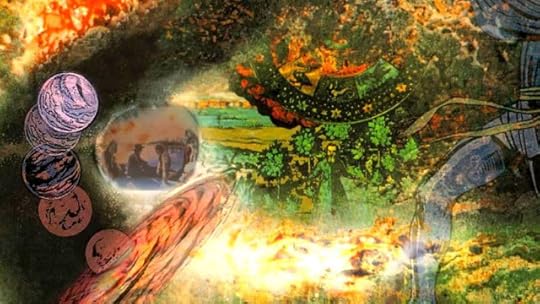
Though the trippy, atmospheric, and discordant Saucerful may have lacked the shimmer and pop of its predecessor, it is a most significant album in the band's oeuvre. Saucerful is the only Floyd record that all five band members appear on; "Set the Controls for the Heart of the Sun" the only song all five members play on together, and the one song that features both Barrett and Gilmour on guitar. It is essentially the first album with the classic Floyd lineup, right down to the band’s longtime graphic designer, Storm Thorgerson. As for Syd, while en route to a performance in Southampton, a band member asked if they should collect Barrett. According to Gilmour, the answer was "Nah, let's not bother." And that was that.
Published on April 25, 2018 05:30
A Saucerful of Secrets - Pink Floyd, 1967
 Recorded at Abbey Road Studios from mid-1967 through early '68. A Saucerful of Secrets was produced by Norman Smith, primary sound engineer on virtually every Beatles recording through the end of 1965. The LP was a milestone in Pink Floyd's history as it marked the end of one incarnation of the band and the beginning of another. Like Yes a few years later, the original band was a far cry from what it would become.
Recorded at Abbey Road Studios from mid-1967 through early '68. A Saucerful of Secrets was produced by Norman Smith, primary sound engineer on virtually every Beatles recording through the end of 1965. The LP was a milestone in Pink Floyd's history as it marked the end of one incarnation of the band and the beginning of another. Like Yes a few years later, the original band was a far cry from what it would become.Unlike Piper at the Gates of Dawn, which had received respectable airplay and critical acclaim, Saucerful failed to chart. Rolling Stone called it "a lot of uninteresting noise," and said it was "boring melodically, harmonically and lyrically" with instrumental work that was "shoddy and routine." Shifting roles within the band was the likely cause, though retrospectively the LP shows the band delving further into the electronic soundscapes they would develop over the next few years. The lengthy (11:57) "A Saucerful of Secrets" suite is an excellent example of melding avant-garde electronic experimentation, Rick Wright's celestially modulated keyboard, and glimpses of song snippets, themes that the Floyd would revisit over the next few years, perfecting them on Dark Side. There is the meditative and somewhat menacing Water's piece "Set the Controls for the Heart of the Sun" and two spacey psychedelic numbers loaded with mellotron by Rick Wright, "Remember a Day" and this writer's favorite "See Saw." "Corporal Clegg" earmarks the catalyst of Roger Water's increasing focus on his father's death in the war and features a few riffs on the guitar from Syd. The truly odd track on the album is Syd Barretts' "Jugband Blues," a chaotic mix of Salvation Army Band (he told them to play whatever they felt like playing), kazoo, and a penchant for asymmetric and surreal lyrics. It would prove to be his last studio performance with the group. Where the LP suffered was in production and yet, 50 years on, the remasters create a whole new sound, well worth revisiting.
 By the end of 1967, Waters, Wright and Mason were becoming increasingly concerned about Barrett, the creative genius behind Pink Floyd, whose heavy psychedelic drug use and erratic behavior threatened to derail them. Mason approached David Gilmour, a college mate of Barrett's, about joining the group as a second guitarist and a sort of understudy for his friend. Gilmour's task was to jump in and cover for Syd should the band's unpredictable leader suddenly decide not to sing or stop playing altogether to wander about the stage, as he sometimes did to the consternation of his bandmates.
By the end of 1967, Waters, Wright and Mason were becoming increasingly concerned about Barrett, the creative genius behind Pink Floyd, whose heavy psychedelic drug use and erratic behavior threatened to derail them. Mason approached David Gilmour, a college mate of Barrett's, about joining the group as a second guitarist and a sort of understudy for his friend. Gilmour's task was to jump in and cover for Syd should the band's unpredictable leader suddenly decide not to sing or stop playing altogether to wander about the stage, as he sometimes did to the consternation of his bandmates.Up until this point, the whimsical Barrett had been responsible for most of the band's music, but with his deteriorating mental state, Syd’s bandmates had no choice but to step in and take over the reins. Of the seven songs on Saucerful, only the closing number, "Jugband Blues," was written by Barrett. The remainder of the album's material was written by Waters, Wright, Gilmour and Mason. Compare that to The Piper at the Gates of Dawn, which was almost entirely written by Syd.

Though the trippy, atmospheric, and discordant Saucerful may have lacked the shimmer and pop of its predecessor, it is a most significant album in the band's oeuvre. Saucerful is the only Floyd record that all five band members appear on; "Set the Controls for the Heart of the Sun" the only song all five members play on together, and the one song that features both Barrett and Gilmour on guitar. It is essentially the first album with the classic Floyd lineup, right down to the band’s longtime graphic designer, Storm Thorgerson. As for Syd, while en route to a performance in Southampton, a band member asked if they should collect Barrett. According to Gilmour, the answer was "Nah, let's not bother." And that was that.
Published on April 25, 2018 05:30
April 24, 2018
The Piper at the Gates of Dawn - The Floyd in Mono
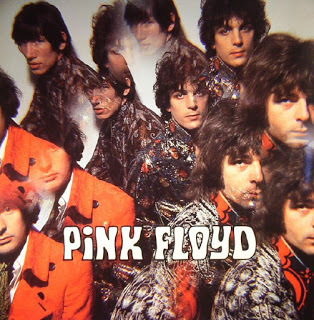 The Piper At The Gates Of Dawn is the set-aside Floyd LP in that it represents the one-up, trippier, less-classic original line up with bassist Roger Waters, keyboardist Richard Wright & drummer Nick Mason led by doomed genius singer/guitarist Syd Barrett. Psychedelic rock doesn't get much more trippier than Piper, a far-out collection of avant-garde space rock; songs about gnomes and scarecrows, off-the-wall production and sound effects, not to mention the superb performances. Although he made one last "cameo" appearance with the Floyd on A Saucerful Of Secrets with that album's closing number, "Jugband Blues," Syd Barrett's legacy with the band is contained right here on Piper (or in the non-LP singles). Writing all but one song, with his charismatic singing voice and incredible guitar-playing skills, Barrett was truly a musical genius, and his equally-talented bandmates match him song for song. Every track on the album is a highlight in it's own right, with tracks like "Astronomy Domine," the before-there-was-alternative alternative "Lucifer Sam," the far-out instrumentals "Pow R Toc H" and "Interstellar Overdrive," or the frenetic rock of "Take Up Thy Stethoscope And Walk" (written & sung by Waters, in his debut composition for the band). After the release of Piper, of course, Syd Barrett's experimentations with psychedelic drugs ultimately destroyed him, and he was finally ousted from the band. Roger Waters more-or-less took over as the group's leader, and Barrett's vacated slot was filled by guitarist David Gilmour.
The Piper At The Gates Of Dawn is the set-aside Floyd LP in that it represents the one-up, trippier, less-classic original line up with bassist Roger Waters, keyboardist Richard Wright & drummer Nick Mason led by doomed genius singer/guitarist Syd Barrett. Psychedelic rock doesn't get much more trippier than Piper, a far-out collection of avant-garde space rock; songs about gnomes and scarecrows, off-the-wall production and sound effects, not to mention the superb performances. Although he made one last "cameo" appearance with the Floyd on A Saucerful Of Secrets with that album's closing number, "Jugband Blues," Syd Barrett's legacy with the band is contained right here on Piper (or in the non-LP singles). Writing all but one song, with his charismatic singing voice and incredible guitar-playing skills, Barrett was truly a musical genius, and his equally-talented bandmates match him song for song. Every track on the album is a highlight in it's own right, with tracks like "Astronomy Domine," the before-there-was-alternative alternative "Lucifer Sam," the far-out instrumentals "Pow R Toc H" and "Interstellar Overdrive," or the frenetic rock of "Take Up Thy Stethoscope And Walk" (written & sung by Waters, in his debut composition for the band). After the release of Piper, of course, Syd Barrett's experimentations with psychedelic drugs ultimately destroyed him, and he was finally ousted from the band. Roger Waters more-or-less took over as the group's leader, and Barrett's vacated slot was filled by guitarist David Gilmour.  At the time The Piper at the Gates of Dawn was released in 1967, it was one among many aurally ripped, acid-tripped albums including Jimi Hendrix's Are You Experienced, Cream's Disraeli Gears, Jefferson Airplane's After Bathing at Baxter's, and, of course, Sgt. Pepper's Lonely Hearts Club Band, which the Beatles were recording down the hall from Pink Floyd at Abbey Road. But as those albums have gracefully slipped into the mainstream of our music consciousness, Piper, along with The Velvet Underground and Nico, still sounds like it broke through from another dimension.
At the time The Piper at the Gates of Dawn was released in 1967, it was one among many aurally ripped, acid-tripped albums including Jimi Hendrix's Are You Experienced, Cream's Disraeli Gears, Jefferson Airplane's After Bathing at Baxter's, and, of course, Sgt. Pepper's Lonely Hearts Club Band, which the Beatles were recording down the hall from Pink Floyd at Abbey Road. But as those albums have gracefully slipped into the mainstream of our music consciousness, Piper, along with The Velvet Underground and Nico, still sounds like it broke through from another dimension.Interestingly, Piper is an LP that I never owned, having discovered Pink Floyd as a teen a few years later, and really only heard the tracks casually or from A Nice Pair. I've been through a modicum of formats for the LP, but recently came across a brand-new experience by mistakenly picking up Piper on vinyl in mono, one of the great mistakes I've made recently. Piper in mono was released on August 5th, 1967 a month before it was released in stereo. (The album's title comes from the title of the seventh chapter of Kenneth Grahame's The Wind in the Willows.)
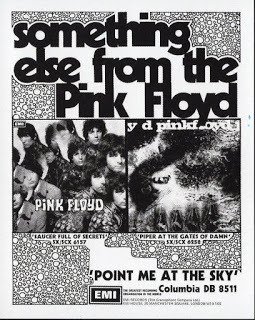 Mono was the main format of the day and so those mixes were done at separate sessions for each track, while the stereo album was mixed in a single day. Mono was where all the work and time went and the stereo mix, like that on Sgt. Pepper, was pretty much cobbled together as an afterthought. The Piper at the Gates of Dawn mono mix is much "punchier" and upfront. It just plain sounds better. However, there are many subtle changes in effect, moment to moment gradations that alter the flow of an entire track. For example, Syd Barrett's whoops and shouts on "Take Up thy Stethoscope and Walk" are simply dripping with delay and the sound collage constantly morphs, unlike the stereo version which is fixed. The coda of "Flaming" is briefer than on the stereo version, as is "The Gnome." There's a layer of organ missing on the stereo mix at the start of "Interstellar Overdrive" with a bongo fade-out and seriously different sections thrown together in "Pow R Toch H." Do yourself a favor: rediscover Piper (an AM7) – or better yet, discover Piper in mono (AM8)!
Mono was the main format of the day and so those mixes were done at separate sessions for each track, while the stereo album was mixed in a single day. Mono was where all the work and time went and the stereo mix, like that on Sgt. Pepper, was pretty much cobbled together as an afterthought. The Piper at the Gates of Dawn mono mix is much "punchier" and upfront. It just plain sounds better. However, there are many subtle changes in effect, moment to moment gradations that alter the flow of an entire track. For example, Syd Barrett's whoops and shouts on "Take Up thy Stethoscope and Walk" are simply dripping with delay and the sound collage constantly morphs, unlike the stereo version which is fixed. The coda of "Flaming" is briefer than on the stereo version, as is "The Gnome." There's a layer of organ missing on the stereo mix at the start of "Interstellar Overdrive" with a bongo fade-out and seriously different sections thrown together in "Pow R Toch H." Do yourself a favor: rediscover Piper (an AM7) – or better yet, discover Piper in mono (AM8)!
Published on April 24, 2018 03:53
April 23, 2018
Piper at the Gates of Dawn - Mono Re-release
 I told you about my Record Store Day haul. Something that I am not, is a collector of new vinyl. Despite the magnificent quality of the 180-gram re-releases, it is rare that I shell out 30 bucks for one LP. As you could see from my haul, $30 bucks goes a long way. Of course, there are exceptions. I own Sgt. Pepper and several of the Steven Wilson remixes like Close to the Edge and Gentle Giant's The Power and the Glory. I will, of course, seek out items that I know will be collectible, but only when I really want them. The 10th-anniversary issue, for instance, of Jack's Mannequin's Everything In Transit, which I scored for $25 and it now worth a couple hundred.
I told you about my Record Store Day haul. Something that I am not, is a collector of new vinyl. Despite the magnificent quality of the 180-gram re-releases, it is rare that I shell out 30 bucks for one LP. As you could see from my haul, $30 bucks goes a long way. Of course, there are exceptions. I own Sgt. Pepper and several of the Steven Wilson remixes like Close to the Edge and Gentle Giant's The Power and the Glory. I will, of course, seek out items that I know will be collectible, but only when I really want them. The 10th-anniversary issue, for instance, of Jack's Mannequin's Everything In Transit, which I scored for $25 and it now worth a couple hundred.My collection though, much of it museum quality, is not a museum collection. I buy vinyl to listen to vinyl, not for posterity; that too with exception. I've played my mint condition Pet Sounds, but rarely. I cherish its provenance; it transcends my collection. The same is true of Pink Floyd's Piper at the Gates of Dawn in its mono Tower label pressing. Like Pet Sounds, I've played it once. But then came an extravagance I couldn't pass up: the Record Store Day release date of Piper in Mono.
The original, is an LP with little personal provenance. Indeed, I didn’t hear "Astronomy Domine" and "Interstellar Overdrive" until the U.S. release of A Nice Pair, which I got for Christmas in 1973. Of course, by '73, everything was in stereo with no one commenting on the superior quality of a mono disk. Over these past 45 years of my interest in Pink Floyd (my first Floyd was a cassette tape of Dark Side that a girlfriend copped for me from Topanga Plaza), I've grown to include nearly the entirety of the Floyd catalog in my rotation (I just can't do The Final Cut, and it's a rare occasion when I listen to Atom Heart Mother), and today I’ve truly added this mono mix 51st anniversary release of Piper. It is magnificent.
Piper's blend of rock, jazz, folk and blues transcends all those genres and combined with its whimsical arrangements, daring improvisations and Syd's surreal lyrics create a truly unprecedented and revolutionary experience for anyone who knows the history of rock (like the readers of AM). The mono vinyl version of the classic LP was released as a limited-edition premium 12-inch, remastered by James Guthrie, Joel Plante and Bernie Grundman from the original 1967 mono mix. 6000 copies were made available for U.S. release and 15,000 copies for Europe on 180-gram black vinyl.

A new LP cover envelope slips over the standard record sleeve (the original, kaleidoscopic album cover photograph taken by Vic Singh – with a prism lens leant to him by George Harrison. The Beatles, if you recall, were recording Sgt. Pepper in Abbey Road’s Studio Two while Pink Floyd was in Studio One). Designed by Aubrey Powell of Hipgnosis with Peter Curzon, this new outer card envelope features a gold emboss of the graphic created by Syd Barrett that appeared on the back of the original mono LP. A 540 x 388mm poster of a photograph by Colin Prime that inspired Syd’s graphic is included inside printed on fine art paper. The package also contains gold and black labels, a gold sticker and a black poly-lined inner record sleeve bag to protect the heavy vinyl disc. The reissue includes the 11 tracks from the album plus the original mono-single mixes of "Arnold Layne," "Candy And A Current Bun," "See Emily Play," "Apples And Oranges" and "Paintbox," as well as the first studio session recordings of "Lucy Leave" and "I’m Your King Bee" from December 1965. So, hooray for all that.
Last night then, I listened to both my 180-gram Piper indulgences: the 2016 stereo release and the new 2018 mono mix. Growing up in the age of stereo, I'm not a mono guy, but I have to admit there is many a nuance that's missed in the stereo version. Hope you didn't miss out.
Published on April 23, 2018 06:33
April 22, 2018
Record Store Day Haul
Yesterday was record store day. Only had 20 bucks. But I still managed a few major scores. I've picked up and put down McCartney's Red Rose Speedway (1973) a dozen times. The more elaborate the album cover, the more possibilities for damage, but bam, $3.99 mint, booklet in place, Braille on back, pristine. So cool. It's one of McCartney's oddest LPs with a distinct flavor, lots of Linda; "My Love" one of '73's biggest hits.
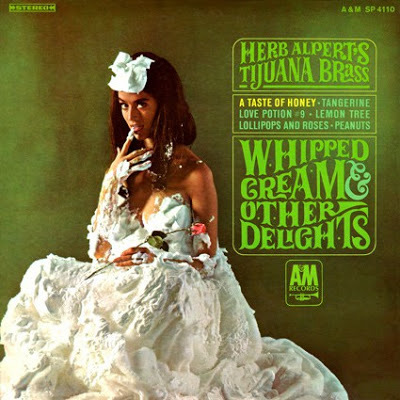 I got Stephen Still's eponymous solo debut, also pretty mint and a gorgeous copy of Herb Alpert's Whipped Cream and Other Delights, one of the most iconic record covers from the era.
I got Stephen Still's eponymous solo debut, also pretty mint and a gorgeous copy of Herb Alpert's Whipped Cream and Other Delights, one of the most iconic record covers from the era.
Got a VG copy of Joni Mitchell's The Hissing of Summer Lawns, which for me serves as a part of the perfect Trilogy of jazz LPs that began with Court and Spark and also includes Hejira. I'll school you a little: Joni arguably can be categorized into several categories: the early, folky Joni from Seagull to Ladies of the Canyon; her Blue period, which also includes For the Roses; the Jazz trilogy, and the rest. I'll get some argument here. Jazz purists will also include Don Juan's Reckless Daughter and Mingus. But for me, Don Juan is just too broad and often scattered. At a total running time of 58 minutes for the two disk set, the LP is far too short to need two LPs and to this writer, there's plenty of editing that would have allowed this Reckless Daughter to again claim an LP equal to Hejira. Instead, we get disposables like "The Tenth World" and "Off Night Backstreet." Think of this single LP playlist instead: "Cotton Avenue" with its magnificent Overture, "Talk to Me" and "Jericho" with "Otis and Marlena" added to Side One along with closer, "Don Juan's Reckless Daughter." It makes for a 25-minute side, that as the LP's producer, I would shaved down to 22. That leaves "Paprika Plains" to Side Two with "The Silky Veils of Ardor." And to solve your issue for the past 40 years, Hejira is pronounced Hedge-Er-A, with a slight emphasis on the first syllable. I digress. The Hissing of Summer Lawns is lush and beautiful, though the LP was generally panned. The fact that Joni ceased looking inward and turned her razor-sharp observations toward society wasn't what fans expected. It was the first time in which her musical direction was questioned. Not by me.
 I got a beautiful copy of Crosby, Stills & Nash and a sealed copy of Alan Parsons' Ammonia Avenue for a buck. Yeah. And last, squeaking it in for just under $20, I got a nice copy of one of my late-night, don't want to wake the fam LPs, Burt Bacharach's Reach Out. (I know, you're not impressed.) Everything in my record shop was 20% off for Record Shop Day and I nearly took the plunge. The shop had a mint, unpeeled '67 version of The Velvet Underground and Nico for $300; with the discount that's $240. Still a bit steep, but gorgeous - and I don't have one!
I got a beautiful copy of Crosby, Stills & Nash and a sealed copy of Alan Parsons' Ammonia Avenue for a buck. Yeah. And last, squeaking it in for just under $20, I got a nice copy of one of my late-night, don't want to wake the fam LPs, Burt Bacharach's Reach Out. (I know, you're not impressed.) Everything in my record shop was 20% off for Record Shop Day and I nearly took the plunge. The shop had a mint, unpeeled '67 version of The Velvet Underground and Nico for $300; with the discount that's $240. Still a bit steep, but gorgeous - and I don't have one!
Wow, what a month: 4-20, Bicycle Day, Record Store Day...
 I got Stephen Still's eponymous solo debut, also pretty mint and a gorgeous copy of Herb Alpert's Whipped Cream and Other Delights, one of the most iconic record covers from the era.
I got Stephen Still's eponymous solo debut, also pretty mint and a gorgeous copy of Herb Alpert's Whipped Cream and Other Delights, one of the most iconic record covers from the era.Got a VG copy of Joni Mitchell's The Hissing of Summer Lawns, which for me serves as a part of the perfect Trilogy of jazz LPs that began with Court and Spark and also includes Hejira. I'll school you a little: Joni arguably can be categorized into several categories: the early, folky Joni from Seagull to Ladies of the Canyon; her Blue period, which also includes For the Roses; the Jazz trilogy, and the rest. I'll get some argument here. Jazz purists will also include Don Juan's Reckless Daughter and Mingus. But for me, Don Juan is just too broad and often scattered. At a total running time of 58 minutes for the two disk set, the LP is far too short to need two LPs and to this writer, there's plenty of editing that would have allowed this Reckless Daughter to again claim an LP equal to Hejira. Instead, we get disposables like "The Tenth World" and "Off Night Backstreet." Think of this single LP playlist instead: "Cotton Avenue" with its magnificent Overture, "Talk to Me" and "Jericho" with "Otis and Marlena" added to Side One along with closer, "Don Juan's Reckless Daughter." It makes for a 25-minute side, that as the LP's producer, I would shaved down to 22. That leaves "Paprika Plains" to Side Two with "The Silky Veils of Ardor." And to solve your issue for the past 40 years, Hejira is pronounced Hedge-Er-A, with a slight emphasis on the first syllable. I digress. The Hissing of Summer Lawns is lush and beautiful, though the LP was generally panned. The fact that Joni ceased looking inward and turned her razor-sharp observations toward society wasn't what fans expected. It was the first time in which her musical direction was questioned. Not by me.
 I got a beautiful copy of Crosby, Stills & Nash and a sealed copy of Alan Parsons' Ammonia Avenue for a buck. Yeah. And last, squeaking it in for just under $20, I got a nice copy of one of my late-night, don't want to wake the fam LPs, Burt Bacharach's Reach Out. (I know, you're not impressed.) Everything in my record shop was 20% off for Record Shop Day and I nearly took the plunge. The shop had a mint, unpeeled '67 version of The Velvet Underground and Nico for $300; with the discount that's $240. Still a bit steep, but gorgeous - and I don't have one!
I got a beautiful copy of Crosby, Stills & Nash and a sealed copy of Alan Parsons' Ammonia Avenue for a buck. Yeah. And last, squeaking it in for just under $20, I got a nice copy of one of my late-night, don't want to wake the fam LPs, Burt Bacharach's Reach Out. (I know, you're not impressed.) Everything in my record shop was 20% off for Record Shop Day and I nearly took the plunge. The shop had a mint, unpeeled '67 version of The Velvet Underground and Nico for $300; with the discount that's $240. Still a bit steep, but gorgeous - and I don't have one!Wow, what a month: 4-20, Bicycle Day, Record Store Day...
Published on April 22, 2018 07:24



